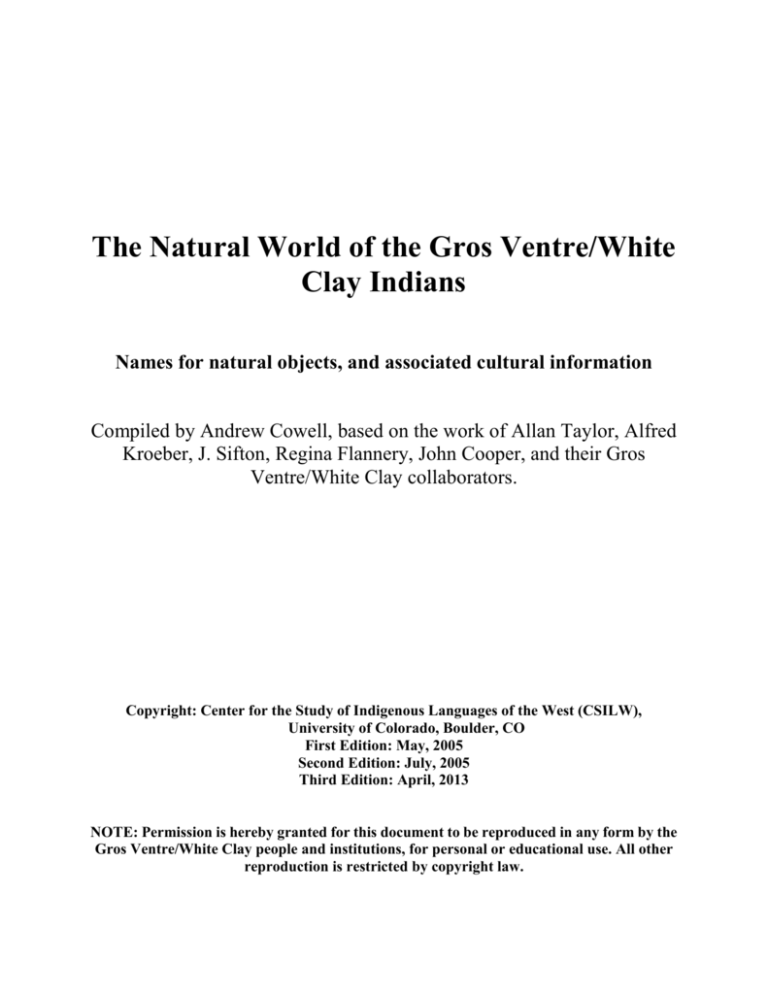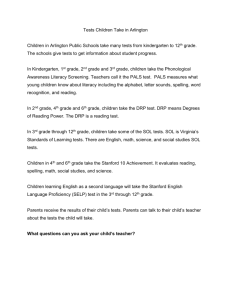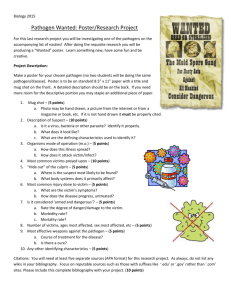The Natural World of the Gros Ventre (Microsoft Word format)
advertisement

The Natural World of the Gros Ventre/White Clay Indians Names for natural objects, and associated cultural information Compiled by Andrew Cowell, based on the work of Allan Taylor, Alfred Kroeber, J. Sifton, Regina Flannery, John Cooper, and their Gros Ventre/White Clay collaborators. Copyright: Center for the Study of Indigenous Languages of the West (CSILW), University of Colorado, Boulder, CO First Edition: May, 2005 Second Edition: July, 2005 Third Edition: April, 2013 NOTE: Permission is hereby granted for this document to be reproduced in any form by the Gros Ventre/White Clay people and institutions, for personal or educational use. All other reproduction is restricted by copyright law. Introduction This is a compilation of information from existing sources. Other than the addition of the word for ‘golden eagle’ provided by Terry Brockie, no new research has gone into this work. The sources from which material is taken are identified as follows: no source = Allan TaylorɁs Gros Ventre dictionary F = The Gros Ventre Indians of Montana, by Regina Flannery and John Cooper K = Ethnography of the Gros Ventre, by Alfred Kroeber # = Gros Ventre Myths and Tales, by Alfred Kroeber (# refers to the story #) S = Gros Ventre dictionary of Father Sifton 2560b = MSS 2560b, compiled by Alfred Kroeber, held at National Anthropological Archives, Smithsonian Institution. Multiple Notebooks (NB) The compiler has provided technical/scientific identifications of many species, based primarily on knowledge of Arapaho and Cheyenne plant and animal names and uses. He has also provided modern retranscriptions of terms transcribed by Kroeber, Flannery, Cooper, and Sifton, and he has provided Gros Ventre forms where only English translations are given in the original sources. 3 BIRDS GREBE FAMILY grebe, pie-billed téiiby(i)h = ‘riding on someone’s back duck’ (possibly coot?) In the creation story, there is a large ‘loon’ (baas-teihipyh) and a small ‘loon’. Both dive for earth, but neither succeeds in bringing any up (Kroeber Myth #2). See also Kroeber Story #28. In Kroeber MSS 2560b, NB 49, he adds that the bird referred to above “can’t fly”. This suggests a coot, which is virtually never seen to fly, though the same could be said of the pie-billed grebe. grebe, western??? baas-teiiby(i)h = large grebe (see grebe, pie-billed) (common loon?) In the creation story, there is a large ‘loon’ (baas-teihipyh) and a small ‘loon’. Both dive for earth, but neither succeeds in bringing any up (Kroeber Myth #2). See also Kroeber Story #28. In Kroeber MAA 2560b, he adds that the bird is “spotted black and white” with a “long bill,” and that the small ones are black. Note: both loons, grebes, and coots sometimes carry their young on their backs. WATERFOWL FAMILY Swan goose gosling nook-óɁeeih = white-goose; nóóc-itétoh = white-heron/egret/crane néɁih néɁiitooɁ (‘young goose’) Goose eggs were eaten (F59) duck duckling cɁíisikoh ciɁíisikóouh (‘little duck’) Kroeber reports that duck eggs were a favorite food (K149); see F59 also. The Duck was one of four divers who tried to bring up earth at the time of creation. He did not succeed. (#1) Gros Ventre shares with Arapaho the story of the dancing ducks. (#14) GULL AND TERN FAMILY gull nowhú-niiɁihíh = fish-bird 4 LONG-LEGGED WADER FAMILY bittern naatóóhow-úúsíit-aakɁi = looks at-sun-it This name comes from the fact that bitterns are masters of camouflage and concealment. When standing among cattails and reeds, they point their head straight up, and with their long neck they look just like another cattail. CRANE FAMILY crane, esp. sandhill Ɂitétoouh (also used for goose) Ɂitéth crane, whooping nóóc-téíth = white-crane/heron (also used for swans) SHOREBIRD FAMILY curlew ɁikóɁuɁúhuh Eggs were eaten (F59). Name also given in Kroeber MSS 2560b, NB49, p 19verso. killdeer ciɁíícikhíh This name is probably an imitation of the birdɁs call. GAMEBIRD FAMILY turkey báas-kénaaɁ = big-grouse GROUSE FAMILY grouse kénaaɁ (prairie chicken or sage grouse) The prairie chicken is central to Gros Ventre pre-Sun Dance preparations (K231) The Gros Ventre version of White Man and the dancing ducks includes ‘Prairie Chickens’ as well (#14). ruffed(?) grouse kóokouɁúhɁuh sharp-tailed grouse tosí-iiinotéyeih grouse hen?) = sharp-tail feathers (also used for sage Eggs of grouse and prairie chicken were eaten (F59) RAPTOR FAMILY hawk, swainson’s? wotééínáátaaɁ (means ‘has worn-out/brown wings’?) Kr 2560b defines this term as ‘chicken hawk.’ eagle, bald nook-oti-yéíhih = white-rump-one 5 eaglet hatiϴeeihih (Kr 2560b, NB 42) nóóotiyéíhiitóóɁ (Ɂyoung eagleɁ) In one story, the Bald Eagle helps kill a mythological monster known as “Cut Off Head” (#3). In another, he rescues a woman from danger and takes her back to her people (#25). eagle, golden cíícííkóto-yéíhih = trilling-one Eagles were shot from blinds set up where a previous camp was being broken (K149). Kr 2560b NB 42 defines this as a “spotted tail eagle.” VULTURE FAMILY vulture FALCON FAMILY falcon Ɂatitebiih (spelling? – from E.S. Curtis) Ɂááyéeih ɁááyaaɁ Kr 2560b, NB 42 defines this word as a gray, swift hawk, smaller than a chicken hawk. kestrel cicíihééíhih ciiciih (Kr 2560b, NB 42) The name for kestrel is also given in Kroeber MSS 2560a, NB 49, p. 19verso, as ciiciihihɁoh (pl.), defined as ‘a small bird.’ OWL FAMILY owl byóótaaɁ Owls were often considered to be spirits or ghosts. snowy owl nooci-byootaaɁ (Kr 2560b, NB 42) KINGFISHER FAMILY kingfisher no name known PIGEON AND DOVE FAMILY pigeon/dove níitééíhɁaaɁ GOATSUCKER FAMILY nighthawk cíítoouh, cííyóúúh The sound of the kingfisher diving was likened to the sound of farting. A traditional saying is: cíítoouh kyááákich! ɁítɁa Ɂóótonnistonéítah ɁínɁ báatah noh niikyóhoɁ. = 6 ‘Nighthawk farted! I’ll make you a bow and arrows.’ (Taylor II.55) The Gros Ventre share the story of the Nighthawk breaking the rock with other tribes (#10). HUMMINGBIRD FAMILY hummingbird no name known WOODPECKER FAMILY woodpecker (in genɁl?) kóókóotaaɁ flicker kóókóotaaɁ red-headed woodpecker baaɁ-áɁaa-kɁi = red-head-it baɁéíhiih = ‘red-headed one’ LARK FAMILY horned lark no name known SWALLOW FAMILY swallow níítotéyeeih = double tail feather (especially barn swallow) cliff swallow bíitéi-wósish = ghost-?? bíitéí-bíitosɁi = ghost-?? Ɂitéi-wós-híh = womanly-???-DIM An Arapaho explained that the cliff swallow is connected to ghosts or spirits because of the strange sound it makes once it returns to its nest in the evening. The second name for cliff swallow is given in Kroeber MSS 2560b, NB 49, p. 19verso, as byiitei-byiiϴoϴo-hoh (pl.). CROW FAMILY crow ɁóouɁ [Curtis 1924, 170 also gives at-ti] Crows were trapped in sinew snares (K149) In one version of the creation story, there are no birds and animals except the crow. The crow must fly around endlessly over the waters. Eventually, it becomes tired, and asks the Pipe Man to create some earth for it to rest on. This initiates the creation. raven ɁóouɁ Ɂótéeih [see ‘crow’ regarding Curtis 1924] jay no name known magpie wouɁúhɁeeih 7 Magpies were trapped in sinew snares (K149) OLD WORLD THRUSHES? starling nhɁáanóouh (same as blackbird, cowbird) CHICKADEE AND TITMOUSE FAMILY chickadee nii-bíííkiy-ééíh = habitual-spring-one (‘he brings springtime’) nii-bíííkyééíhihi-kɁi = habitual-little spring-one (‘he’s the little bringer of springtime’) The song signals the arrival of spring for the Arapaho, and the Gros Ventre word seems to indicate the same thing. In Kroeber 2560a, NB 49, p. 19verso, the name is given as byiikiy-eeihihɁoh (pl.) Ɂíckiikiikhíh (apparently onomatopoetic for the call) bííbineihíh = ‘small berry eater’ bííbineihihí-kɁi = ‘he is a small berry eater’ THRUSH FAMILY robin béɁ-isicééí-(hiih) = red-breast-one bluebird kináatáán-iiɁíhiih = blue-bird SPARROW FAMILY sparrow ‘winterbird/snowbird’ no name known c/siiɁhihɁoh (Kr 2560b, NB 42) ‘snowbird, sparrow’ Ɂísiih (probably junco) BLACKBIRD FAMILY red-winged w blackbird nííyos-nihɁáanoouh = cattail-blackbird meadowlark Ɂíbikííwoochíh Meadowlarks were believed to talk dirty, and to mock people. One non-dirty call is: cííyóóuúh náhtonáhɁ = ‘nighthawk, you are tricky/smart’ (Taylor II.55) The eggs were hard-boiled and fed to children who were slow to learn to talk (F59, 143) and when a person is talkative, people say ‘their mother must have fed them meadowlark eggs’ yellow-headed h blackbird no name known blackbird nhɁáanóouh 8 brown-headed cowbird nhɁáanóouh grackle nhɁáanóouh FINCH FAMILY ‘winterbird/snowbird’ Ɂísiih (This is either a Snow Bunting or Junco) 9 MAMMALS INSECTIVORES mole BATS bat nóou-ciitóóc-ééíhih = outside-blow (dirt)-it (=Arapaho gopher) woosí-ciitóóc-ééíhih = dirt-blow-it kiikííbyɁ-ééíhih wɁatáán-ntɁín-eih = black-wing-one The bite of bats is thought to be poisonous (K281) RABBITS rabbit nooch cottontail nowóot-óóch = lefthanded-rabbit jackrabbit báat-óóch = big-rabbit (wh-tl jackr) nóók-óóch = white-rabbit (wh-tl jackr) Rabbits eaten when necessary, but normally considered trapping fare for children (F59) RODENTS chipmunk no name known marmot no name known ground sq totooyoɁeeih = ‘striped one?’ Kr 2560b says this word can be used for all kinds of squirrels. squirrel same as ground squirrel? gopher gopher hole Ɂóniiih nóóúciitóóto(o)Ɂ = ‘product of blowing out’ (i.e. the dirt blown out of the ground) Gophers [prairie dogs?] were trapped by means of horsehair hoops (K149) Eaten when necessary, but normally considered trapping fare for children (F59) prairie dog pr. dog town báat-óniiih = big-gopher baatónííí-taanɁo = prairie dog-village 10 Eaten when necessary, but normally considered trapping fare for children (F59) beaver beaver dam ɁábisɁ ɁábisɁ ɁókoouyóoɁ Most favored meat after hooved animals (F59); skin used for caps, mittens and breechclouts in winter (F62) Castor put into paint bags so that daily paint materials would smell sweet (F63) mouse baby Ɂoocíih ɁoocíihiitooɁ (‘young mouse’) rat báat-óócíih = big-mouse woodrat báat-óócíih = big-mouse muskrat Ɂíitósih Bags sometimes made from the pelt (F62). Used as trimming (F62) porcupine porc. quill Ɂóouh Ɂóóninoh (pl) Porcupine quills were of central to decorative uses; also eaten (F59). Tails used for combs (F63) CARNIVORES coyote rutting male kóóɁohwúh nó(ó)nisi-kóóɁohwúh = crazy-coyote nóónitehíínotáasiɁ = ‘he is wandering around crazy’ Young sometimes eaten (F59) wolf rutting male kyáakítaaɁ nó(ó)nis-kyáakítaaɁ = crazy-wolf nóónitehíínotáasiɁ = ‘he is wandering around crazy’ Scouts were called ‘wolves,’ and if they had seen another camp on their trip, they howled like wolves upon returning to camp (K191) Young sometimes eaten (F59) red fox báat-oouh = red-swift fox swift fox nóouhháh 11 Foxes were trapped (K149). The swift fox was involved symbolically in the kit fox lodge (K231). Used as trimming (F62) bear cub wósɁ wóuɁuh wóúɁuutóóɁ grizzly nonóóc-íikétó-Ɂ = white-shoulder-one nonooc-íikétoɁoni-kɁi = white-shoulder-one noo-iϴoouɁeen-osɁi = white-???-bear (2560b) black woɁaatáán-osɁi = black-bear Bears were trapped (K149) Not sought for food, but eaten when killed. The grease was saved and used (F59) raccoon wooɁatáán-oocí-kyɁ = black-eye-it marten Ɂotótah (spelling? – from E.S. Curtis) fisher néeiyɁo [same as ‘otter’?] noɁohoɁ [Kroeber NB 42; same as ‘mink’] weasel téih Used as trimming (F62) bf ferret báatónii-téih = prairie dog-weasel mink n(o)ɁóhoɁ Bags sometimes made from the pelt (F62). Used as trimming (F62) wolverine ɁóhɁánɁ bóhɁouɁ = mtn badger badger bóhɁouɁ The badger is involved symbolically in the crazy dance (K231); also eaten (F59) skunk tóouh otter néeih Fur used for caps and mittens in winter (F62) Bags sometimes made from the pelt (F62). Used as trimming (F62) 12 mtn lion bitóókyaaɁ Ɂaabetyiih ‘big one’ (Kr 2560b, NB 42) bobcat tow-óón-néíhii-bitóókyaaɁ = short-tail-one-mtn lion lynx no name known HOOFED MAMMALS elk Ɂiwósiih Elk horn was used to make hide scrapers (K150); teeth were the most important decorative item on clothing (F62). The name for the teeth is Ɂiwosiihoocit. mule deer buck fawn bíhɁih bíhɁihiih Ɂiwotóótibiih Ɂanaakei-bihɁih (Kr 2560b) wóuɁuh wóúɁuutóóɁ Polished deer hooves were attached to robes and clothing and left to dangle because they made a nice sound when one walked (F62) white-tail deer Ɂótiby-oonín-eih = dog-tailed-one moose Ɂinénhih pronghorn noosíkyíh bison bull female herd calf ɁíítaanóónɁi ɁanáákyaaɁ biih ɁíítaanóónɁi wóuɁuh wóúɁuutóóɁ nihóóni-wóuɁ = yellow-calf no name known buff chip Bison were the central animal of Gros Ventre culture. See K148-49. bighorn Ɂótééíh mtn goat no name known caribou no name known 13 Additional General Information Though bison hides were used for robes and tipis, deer, elk, and antelope were normally used for clothing (F61). Elk was more durable, but deer was more flexible and preferred for the finest clothing (F62). Antelope was preferred for breechclouts (F62)) Food and water containers were made of buffalo heart membrane, paunch, bladder and intestines, as well as those of elk and deer (F64-5) 14 “CREEPIES AND CRAWLIES” REPTILES snake síisííyaaɁ Snakeskin was sometimes used to cover and ornament bows (K151) rattlesnake síisííyaaɁ níí-síísiiyóni-kɁi = habit-rattle-it bull/gopher ɁótaaɁ garter snake Ɂiníícih turtle bɁánóouh lizard kóóhoyaah Lizards are believed to bite people and then hang on and suck their flesh into their mouthes (K281). 2560b gives koohootyaah. horned toad ɁitóóníwooɁ The horned toad was used as a decorative emblem (K167) AMPHIBIANS frog tadpole toad INSECTS AND SPIDERS insect kokóáh wóówooɁóócííh kokóóhii-tooɁ = frog-young kóuɁ-kokóáh = swollen-frog kóuw-kokóáh = swollen-frog byíítaaɁ ant anthill wóówos-tóyɁéíhiih = bad-biter wóówostóyɁéíhyóh Ɂí-yééíhɁ-iinínooɁ = ants its-lodge-pl bedbug téɁ-téibɁi = flat-louse bee beehive ɁóówɁu Ɂóówuu-níiinɁo = bee-lodge 15 honey butterfly caterpill tent cat Ɂóówuu-baaɁ = bee-excrement bohɁóon-téíbeih = thunder-louse bíis-bíítaaɁ = hairy-worm/bug byoosou-biitaaɁ = bare(?)-bug [Kroeber NB#42] ɁóoounóɁohootééíh Tent caterpillars are believed to dance if one sings or plays a drum for them centipede ɁanináatétaaɁ (= ‘whirlwind’ as well) cricket Ɂisíktóneih dragonfly bíítooh-óotɁa = ‘insect-horse’ Definition given in Kroeber MSS 2560b, NB 45, p. 25. He gives the word as byiiϴoo-hooϴibyii (pl.). flea béɁ-teibyɁi = ‘red-louse’ fly nóubaa (see ‘spider’) grasshopper níhɁaacéeih hornet hornet’s nest ɁóówɁu Ɂóówuu-níiinɁo = ‘bee-lodge’ horsefly kohɁácaaɁ leech wóówooɁóócíih ɁanináatétaaɁ (also = ‘whirlwind’) louse nit Ɂa-téibɁi = your-louse yáanah maggot Ɂaníiih (also ‘larva’) mosquito kóouɁ-ééíhih = swelling-one One of the Gros Ventre age-grade dances was given by the mosquito, and that insect is imitated in part of the dance (K231) moth Ɂohóókyaa-nén = crazy-man [Miller Moth] The Crazy ManɁs society went by the same name as this moth. 16 spider daddy long-legs níhɁootoh Ɂaay-óonaa-kɁ níhɁooth = long-leg-it has spider tick Ɂisíiih wasp Ɂóów water strider noosíkyih (= ‘antelope’ as well) WORMS worm byíítaaɁ ‘red legless water worm’ ɁanináatétaaɁ MOLLUSKS shell abalone shell dentalium shell oblong shell mollusk shell FISH fish dead fish fingerling = ‘whirlwind’ (K280) byéeiɁih (especially freshwater mussels, ‘moon shell’) kookooɁoϴeiht [Kroeber NB 41] ɁaɁayooniihihɁoh [Kroeber NB 41] = ‘long-bodied ones’? kookooɁateihihɁoh [Kroeber NB 41] (used in place of elk teeth) ɁoohohoɁ [Kroeber NB 41] nówuh nikíínowóhɁo (‘dead fish’) nówuutóoɁ (‘young fish’) Kroeber reports that fish were only caught by children for amusement (K149) minnow nówuu-tóoɁ = fish-young sucker kóóɁaan-ék-Ɂi = round-mouth-it has 17 PLANTS GENERAL TERMS bark berry branch bush, brush flower grass leaf nut root sap, pitch, gum seed, pit or stone of fruit stem/stalk thorn tree appear (grass) appear (new growth) brushy, to be fall (leaves) new growth, to have thick (grass) unripe, to be ɁinóoosɁi biiɁ or byiiɁ -ibyinoh or -ibinoh or -uwunoh (as noun suffix) ɁitéɁ ɁíikóúɁ or nááyáach -bíisɁ or -wúusɁ (as noun suffix) nɁíiɁóotóónoh (= ‘growing things’) -aɁaa- (as incorporated form in verbs; = ‘head’) wosíɁ -otoo (as incorporated form in verbs) bíicíísɁ -ikoo (as incorporated form in verbs) niikóóɁówuh ɁíníiicɁi -ítaan (as incorporated form in verbs) tóóúɁ or kéeiɁ or kyéiɁi cíicsíbɁi -oocééí (as incorporated form; = ‘rope’) khúu- = ? ɁohóókɁi bíítotoobíítoɁookyoɁooɁeekyánikóobíísíiiɁoowóóníiiɁóokyóɁotookináatáánéhi- 18 FORMAT: FAMILY NAME (English version of family name) Plant species [Common English name] Gros Ventre name = English translation of GV name Notes on uses of the plant CUPRESSACEAE (Cypresses) Juniperus communis [Common Juniper] kóhkɁunáásibɁi = ‘roll in the dust’ (?) béɁ-itáacɁ = red-pine berries kyóóóhɁtowúnoh Used to cure asthma (K226) leaves kyóóóhɁtowúukooɁ (accent?) Used as remedy for hemorrhage (K226) Used as incense by doctors, prior to work (K226) Juniperus horiz. [Creeping Juniper] táatoou-wúusih = pine-bush The previous word and identification is also given by Kroeber (MSS 2560b, NB 46). Used for incense, and also for hemorrhages. Sabina scopulorum (?) [Rocky Mtn Juniper] béɁi-táacɁ = red-pine PINACEAE (Pines) Pinus spp [Pine] táacɁi ϴaacibinoh (nuts from cones) Pine nuts were used for pemmican (K227); gum was chewed (F60) Abies lasiocarpa [Subalpine Fir, Sweet Fir] nɁ-íbyóoot(o)h = good-smell nɁ-íbyoou-táacɁi = good-smell-pine Used as ceremonial incense (K225). A tea made from the leaves applied to the body to relieve pain (K225) Pseudotsuga douglasii [Douglas Fir] ASCLEPIADACEAE (Milkweeds) kiyótow-táacɁi = false-pine 19 Asclepias spp [Milkweed] Ɂohookiinitooh = Ɂit is wood likeɁ (K224) Kroeber 2560b, NB 44 was this was used for colic. ACERACEAE (Maples) Acer negundo [Box Elder] tóótó-ousɁi = ???-bush The juice of the inner bark was sometimes eaten in spring F60 Fraxinus pennsy. [Green Ash] ɁinénouɁú-bisɁi = fake/false-wood Ash wood was used for bows (K150) ALLIACEAE (Onions) Allium spp [Wild Onion] Ɂitóou-kɁa = skunk-turnip These roots were dried and stored for later use F58 ANACARDIACEAE (Cashew Family) Rhus trilobata [Skunkbrush, Sumac]? cooti-binoh = enemy-berries K227 ‘Piegan berries’ were chewed, then rubbed on hair, horses and beddings as perfume F63; K 2560b, NB 44. APIACEAE (Parsleys) Cicuta maculata [Water Hemlock] kikyáacaaɁ Heracleum lanatum [Cow Parsnip] kocíyɁo = Ɂgun, whistleɁ Lomatium dissectum [White Turnip] niɁ-aataaɁ = good-?? Used for tuberculosis and hemorrhages (K226). Eaten, and drunk as a tea (2560b, NB 44). Perideridia gairdneri [Yampa] ninííshíh-kɁi = be two-it (a reference to the roots) These roots were dried and stored for later use F60 ASTERACEAE (Composites) Artemisia frigida [Fringed Sage] ɁááskóoɁ Artemisia ludoviciana [Meadow Sage] nóók-hóotɁa = white-bush Tipi floors were covered with sagebrush in the summer (F64) 20 Echinacea angustifolia [Purple Coneflower]? Ɂotowoo-nosiɁ =dog-medicine/grass Used for pleurisy and heart sickness, and in age-grade ceremonies (K226). 2560b, NB 44 gives a plant ɁitowoonosiɁ, which looks like this word (but see Mertensia below); however he describes it as having bright red berries, a low plant, dark, pointed leaves, length and width of the thumb. The root was used. It has one root the size of a finger and many fine, hair-like roots. It was used for pleurisy and heart troubles, and was chewed or drunk, and tastes sweet. Grindelia squarrosa [Gumweed] kiikéhtaaci-bíisɁi = ?-bush Helenium hoopesii [Sneezeweed] ɁitowhóóɁ Kroeber 2560b, NB 44 says it was obtained from other tribes, did not grow in the GV area. Lygodesmea juncea [Rush Skeletonweed] no name known Used to increase a motherɁs flow of milk (K225) ‘yellow heads’ niihoo-naɁaa-noouh = yellow-head-it (K225) 2560b, NB 44 says also called tyityih-taasibyisih. It was used to incense women after they gave birth. BETULACEAE (Birches) Betula spp [Water Birch, Mtn Birch] BORAGINACEAE Mertensia spp [Mtn Bluebells] CACTACEAE (Cactuses) All Cactaceae spp CAPRIFOLIACEAE (Honeysuckles) Symphoricarpos albus [Snowberry] níííyooɁóoɁ Ɂotowoon-osiɁ = good-medicine totowoon-osiɁ = good?-medicine ɁóhoyóoosɁi nooc-íbinoh = white-berries CONVOLVUCEAE (Morning Glories) Convolvulus spp [Morning Glory] cííkon-táánocɁ = ghost-rope CORNACEAE (Dogwoods) Swida sericea [Red-osier, Red Willow] berries bɁ-ócééí-bíisɁi = red-bark-shrub nooc-íbinoh = white-berries 21 ELAEAGNACEAE Shepherdia argentea [Buffaloberry, Bullberry] Thicket kyáakitáá-binoh = bull-berry kyáakítaa-bíisiiɁ = bullberry-bushes ERICACEAE (Heaths) Arctostaphylos uva [Bearberry, Kinnikinnick] berries nóuhɁúúwun-bíisiih = ??-bush nóuhɁúúwuno These berries were available for use in July F60 FABACEAE (Peas) GlycrrhiɁa lepidota [Licorice Root] Psoralea esculenta [Indian Turnip] biiɁáɁaaneih-íisɁi = sweetheart-plant ɁíikɁa kínaaɁ These were available in August F60 – very important food ‘bean’ ɁiwonííhóóhoɁ ‘potato’ kyooɁóóh = ‘it is spherical, round’ Used as food, but found only in Sweet Grass Hills, Moccasin Mountains, south of the Little Rockies, and around Billings F60 ‘yellow turnip’ nihóón-íikéniiɁ = yellow-turnip ‘red turnip’/’beet turnip’ no name known Used as food, but found only sporadically in sandy places F60 GROSSULARIACEAE (Currants and Gooseberries) Ribes spp [Currant] nɁ-íbyinoh = good-berry These berries were eaten fresh F58 Ribes glossularia(?) [Gooseberry] Ɂítétoocíi-bɁi = astringent-berry There berries were dried and stored for later use F60 JUNCACEAE (Rushes) Juncus balticus [Rush] ɁohootinaɁ (spelling? – from Kroeber) Used for embroidery (K227). Described in 2560b, NB 44 as a water plant, the whole plant used for the quillwork. 22 LAMIACEAE (Mints) Mentha arvensis [Field Mint] woos-wóhooɁ = elk-mint Used for headache, and drunk as a tea (K226; F61) Monarda fistulosa. [Horsemint] kyaanáátaa-náɁaa-nóouh = blue-head-it LILIACEAE (Lilies) Veratrum viride [False Hellebore] ɁitowhóóɁ (II.255) = ‘sneeze weed’? Camissia quamash [Camas Lily] kookóóɁaa-báá-noh = Flathead-feces-PL The name for this plant likely comes from a story told by the Flathead Indians themselves, in which Coyote mistakes Camas Lily bulbs for feces. The Gros Ventres evidently told a variant of this story. POACEAE (Grasses) general [Grass] wosíɁ Hierochloe odorata [Sweetgrass] níɁ-osɁ = good-grass Rye Grass no name known Tipi floors were covered with rye grass in the summer (F64) POLYGONACEAE (Buchwheats) Rumex spp (obtusifolia?) [Sheep Sorrel] nihoon-ósiɁ = yellow-medicine/grass [I.356] See K226. Kroeber 2560b, NB 44 says ‘yellow medicine’ was the root of elk plant, or elk root, and that it was a low plant, with small burrs. This may not be the same thing as the plant identified above. PORTULACACEAE (Purslanes) Lewisia rediviva [Bitterroot] béíɁ-ítaan-óóh = red-root-it These roots were dried and stored for later use F60 - very important food ROSACEAE (Roses) Amelanchier spp [Serviceberry, Juneberry] ɁihéyouɁ-úwunoh = heavy-berries These berries were dried and preserved for later use F60 - very important food Crataegus dougl. [Hawthorn] khúú-wunoh = thorn-berries khúu-wúusɁi = hawthorn-bush 23 Fragaria spp [Strawberry] Ɂiteih-íbyinoh = heart-berries These berries were eaten fresh F60 Padus virginiana [Chokecherry] thicket pit toyh-úwunoh = ?-berries ɁóóówouɁ toyohúwuni-cíicisíbɁi = chokecherry-pit ‘Cherry’ wood was used for bows (K150) The berries were available in August F60 - very important food A tea was made from the bark and roots F61 Tipi door fastening pins normally made of this wood F64 Prunus americana [Wild Plum] báas-íbinoh = big-berries These fruits were available for use in July F60 Rosa spp [Wild Rose] rose hips yáaniih (pl) The fruits were gathered after the first frosts, though available by late August F58 Rubus spp [Wild Raspberry] ɁoonyóɁ These berries were eaten fresh F58 SALICACEAE (Willows) Populus deltoides [Cottonwood] kiyotów-hóókɁi = false-tree [but see II.387] The juice of the inner bark was eaten in spring F61 Populus tremuloides [Aspen] cíhɁo-hookɁi = slender-tree [but see II.387] Salix spp [Willow] níícoosɁ Willows were used to make hoops, within which sinew was woven to trap crows and magpies (K149). It was used to make many implements, including children’s toy shields (K182) and backrests (F64). A willow ring encircled the fireplace in tipis (F64). Tipi floors were covered with willow in the summer (F64). THALICTRACEAE (Meadow Rue) Thalictra spp [Meadow Rue] ??? 24 This plant was so much associated with the Gros Ventres that it was called ‘Gros Ventre plant’ by the Blackfeet. It was used as a perfume. Kroeber’s Ethnology records four names for four different plants used a perfumes. Based on the other uses recorded for the plants, it seems likely that ??? was the Gros Ventre name for Meadow Rue. TYPHACEAE (Cattails) Typha spp [Cattail] nííyóns-íisɁi = tongue-bush Ɂííyons-íisɁ = has a tongue-bush VITACEAE (Grapes) Vitis spp [Wild Grape] woɁátáán-bíínoh = black-berries IDENTITY UNCLEAR ‘Buckbrush’ no name known Brooms of this material were kept in tipis (F64) [Symphoricarpos spp? Ceanothus spp? (see Fendler’s Ceanothus and Snow Laurel of the Boulder, CO area)] LICHENS Evernia vulpina [Lichen] ɁocohooɁ (spelling??) Used to make a yellow dye for quills (K227) ?? banaacinɁ (spelling?) [K225 (a rock lichen)] FUNGI/MUSHROOMS Mushrooms in general tos-eɁeinoo-uh (spelling? – from Sifton) = They have ??? heads Dried mushrooms in general were sometimes used for kindling (K150) Fungus spp nóók-osíɁ = white-medicine (large fungus growing on trees) General medicinal use (K226). Grows “high on pine trees” (2560b, NB 44) Puffball spp wústoonóokhooɁ wústaanóokhooɁ ?? caacnooɁ (spelling??) [K225 (a fungus on birch)] 2560b, NB 44 gives this as ciityinoo, and says it was for wounds and sores, and when set of fire, glows. MOSS General word haccáan (spelling? – from Sifton) 25 Unidentified Medicinal Plants (details on uses are in Kroeber) NAME MEANING PAGE REFERENCE (Alfred Kroeber “Ethnology of the Gros Ventre”) báakyékɁi ‘hand’ 2560b, NB 44, small piece laid in cold water, the drunk to make delivery easy. Name based on shape of root. K225 ‘red medicine’ K224 kyaakyaanitoo-h (sp.?) ?? Described in 2560b, NB 44 as a root, growing in swampy country, soaked in water, then the black part kept, grated, mixed with water, and applied to a sore neck. K225 c-aaɁaanoo-uh ‘bunches’? 2560b, NB 44: used for perfume, hair wash, tea - which makes hair grow. Branches used for perfume. Tea was poured down nostrils for headache. K227 Ɂayoot(o)h (sp.?) ?? 2560b, NB 44 says a piece was tied to the shoulder of oneɁs shirt, and worn as perfume. It was also used for sore eyes: laid in warm water, but not boiled. K225 Ɂiinoosaanitoo-h (sp.?) ?? 2560b, NB 44, A bark, not grow in GV area, chewed or drink, for hemorrhages or pain in the back. K226 Ɂiniitsooh (sp?) ??(=horn?) 2560b, NB 44, roots of a grass, boiled, the water used for pain and sores. K225 beɁ-osiɁ 2560b, NB 44, redish when fresh, used for diarrhea. Ɂicaatyinoo (sp?) 2560b, NB 44. Grows on birch trees, near the root, and was used for childrenɁs teeth pain. Pulverized, put on gums. kyaakyaciko-uh (sp.?) ‘spotted’?? A tea was made from this, leaves growing in the mountains. 2560b, NB 44 (Kaakaatyikouh). Later in same MSS defines this as ‘flat leaf’ and says was used for general medicine. kouhuuyoo-h ‘sticky’ K226 K225 26 2560b, NB 44, chewed, then made into a paste. For sores. A low plant with sharp leaves. niniicitoo-h ‘hollow’ K226 For horses, drunk as tea for colds, plant very much like wild parsnip (2560b, NB 44) niihoon-aɁaanoo-uh ‘yellow heads’ 2560b, NB 44. Grows by water, drunk as tea for sickness in body and pain in the back. K225 nii-tosiɁoo-h ‘sharp’ 2560b, NB 44 describes this as the root of a plant, with a bunch of spear-like leaves. It was pulverized and used for sore mouth and tongue. K225 niɁibyoootɁi ‘smells good’ K227 2560b, NB 44 identifies a ‘perfume’ which was the stems and leaves of a small plant. now-osiɁ Root of a water plant, eaten for colds (2560b, NB 44) ‘fish medicine’ tóutitóoɁ ‘mixture’ (for smoking) [Taylor Dict] K226 wonoosi-byooo-Ɂ ‘smelling loud’ In 2560b, NB 44, this looks like nonoosi-byooo-Ɂ. It was smoked in a pipe for headaches. K226 wonou-wosiɁ ‘wart medicine’ In 2560b, NB 44, this is said to be used for stomach ache. It is the root of a plant growing by the water, with curved over ovate leaf, fuzzy inside, and sweet-tasting. K224 Ɂítaan-wosíɁ ‘woman-medicine’ (love medicine) [Taylor Dict] 27 THE HEAVENS Big Dipper taab-íikéto-Ɂ = broken-back-it Eclipse Ɂiníínóóútaa-kɁi = Ɂit has disappearedɁ Falling Star ɁótoɁ kyaanís = star falling meteor shower ɁotoɁuu cenis = stars falling (Kr 2560b) Milky Way cííkon-byóooɁ = ghost-road Moon new moon Moon and Sun biikóóú-síisɁi = night-light Ɂthe one travelingɁ (Cooper) Ɂíniisíísoyooh Ɂiniit-eiɁiit-iisiisɁi(?)= complete-?-light (Sifton) ɁiníísíiiɁoo-kɁi = grown to maturity-it Ɂonóóúci-Ɂ = ‘it is visible’ ‘they follow each other’ (Cooper) Morning Star nookoosɁi = cross Northern Lights nihɁóótoou-sítaa(noh) = White Man/Trickster’s fire Pleiades bóón-ocí-ch = together-sit-they bóóh-ocí-ch = together-sit-they rise (sun or moon) bíísítaa- = ‘to come into view’ set (sun or moon) Ɂinowútaa- = ‘to go out of view’ Sky ɁónoɁ Star 3 stars in orionɁs belt 2 stars below orionɁs belt ɁótoɁ; botoɁ [Sifton]; ɁotouhoɁ (Sifton) ‘buffalo bulls’ (K280) = Ɂanáákyaanoh ‘hunters’ (K280) = ɁíínooɁéíhóóh Sun sun dogs ɁíísíisɁi ɁiisiisɁi wonoo-wokitonaa-ch = ‘the sun is lighting a fire’ [Sifton] ɁiisiisɁi nii-wokitonouhu-kɁi = ‘the sun is lighting a fire for itself’ Ɂiisiiϴ-otoo = sun-??? (Kr 2560b) moonlight full moon sun rays located in the sky Ɂonóóúci-Ɂ = it hangs 28 THE SEASONS AND THE MONTHS Note: some of these month names are clearly post-contact names, and refer to key events occurring in the standard American calendar month (July = ‘fourth of July month’; September = ‘when the children go back to school’; November = ‘thanksgiving month’; December = ‘Christmas month’). The other months are actually names for various full moons. The full moon may occur at the END of the respective American calendar months; the seasonal events described in the traditional moon names should be considered as occurring at the END of the month in question. January Ɂóhuu-nókoootoo-h = ‘when it is very cold’ February February totóó-úsíisɁi = ‘in-between month’ béih-ííísíisɁi = ‘treacherous, tricky month’ March nohɁóúɁaanoh Ɂóhuu-tóyaɁáá-ch = ‘when snow insects bite’ April April April April April ɁínɁ Ɂóhuu-bíísikoo-Ɂ = ‘when the leaves appear’ Ɂóhuu-béniiɁówu-h = ‘when it thaws’ báániiɁowúúsih = ‘thawing month’ ɁínɁ Ɂóhuu-bíítotoo-h = ‘when grass appears’ béniiɁowúú-úsíisɁi = ‘thawing month’ May May ɁínɁ Ɂóh-oooɁóotootaa-h = ‘when blizzards end’ Ɂóhuu-bíítotóo-h = ‘when the grass appears’ June June ɁinɁ ɁihéyoɁúwunoh Ɂohúú-útitée-ih = ‘when serviceberries are ripe’ bíínoh Ɂohúú-útitéé-íh = ‘when berries are ripe’ July July Ɂiitétoocíibinoh Ɂóhuu-utetohɁu-ch = ‘gooseberries when ripe’ bííkini-báási-bétaan-ííísíiisɁ = ‘summer big holiday month’ August August August tóóyóóúnoɁó-Ɂ = ‘it is fall’ Ɂóhuu-tóyóóúnoɁó-Ɂ = ‘when it is fall’ ɁínɁ toyohúwunoh Ɂóhúú-útitée-ih = ‘when chokecherries are ripe’ September Ɂóhuu-cíikyááá-ch téɁiyoonóhooɁ = ‘when the children go in’ October October Ɂóhuu-k(y)énikoo-Ɂ = ‘when leaves fall’ Ɂóhuu-kénité-Ɂ biiciisiih = ‘when leaves fall’ November báasíkénéé-ísíiisɁ = ‘turkey month’ December kécini-báasi-bétaan-ííísíisɁi = ‘winter big holy day’









